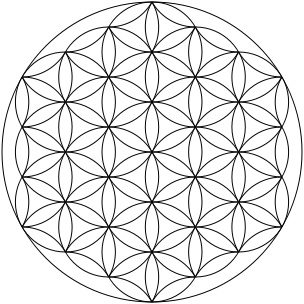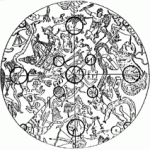As we saw above, our earliest surviving alchemical text, the Egypto-Hebraic “Isis the Prophetess,” tells us that Isis received the secrets of alchemy from a composite being whose name is suggestive of the cabalistic Tree of Life. But what, exactly, is the Tree of Life?
To the ancient Egyptians it was the Djed pillar, the backbone of Osiris. The djed began as a power object to the Neolithic cultures of the Nile delta. It symbolized “stability,” or rather “divine establishment.” The world tree or divine axis is a common motif in shamanic practices indicating an awareness of the infra-structure of the universe. As this idea became a word, it was associated with similar sounding words in order to give it a phonetic spelling. The roots of these words form a complex that encompasses the concepts of speech, including divine speech, the culmination or zenith of a star, and an olive tree, the tree of life itself. This tells us that the ancient Egyptians thought of the Djed as something divinely pronounced, a word-tree that links the earth and the stars.
Interestingly enough, The Indo-European group of languages have a complex of root words that are very similar to that which we have just outlined in Egyptian. The world tree in this case is the oak, *drw in ancient Indo-Aryan. Just as the olive tree was the Tree of Life in the Mediterranean — because of its ability to supply food and therefore ensure stability — it was the oak that provided stability for the ancient proto-Europeans wandering in the vast forests of the post-glacical warm spell. The word for oak also meant firm, strong, stable and enduring. Our modern English words truth, trust and even tree come from these roots. Druid is also in the *drw family and means “seer of the oak.”
In Sanskrit, another Indo-European language, the word for tree is daru, a derivation of *drw. In the Rigveda, the ancient ceremonial hymns of the Indo-Aryan conquerors of India, we read that the Tree is the material “from which the gods have fashioned Heaven and earth, the stationary, the undecaying, giving protection to the deities.” The Tree is the cosmic pillar around which the entire universe was thought to revolve. This world tree was often shown in Indian folk art as a great tree crowned with the Pole Star, which is called dhruva, another derivative of *drw, and which meant the firm or fixed one.
Rationally, this idea of the Pole Star as an eternal tree strikes us as a kind of nonsense. Yet, in an experiment conducted by Dr. Jonathan Shear of Maharishi Univerity in the late 1970’s, we find that this tree embodies a strange kind of truth.
The experiment centered around a sutra in part three of Pantanjali’s Yoga Sutras which states that “by performing samyama on the Dhruva, the Pole Star, one gains knowledge of the motion of the stars.” Samyama is a deep state of rapport which allows for an actual transfer of energy or information with whatever one is focusing on, be it an image of deity or the Pole Star.
In his paper, published in the January 1981 edition of the journal Metaphilosophy, Dr. Shear reports that he expected his subjects, all skilled meditators, “to perceive the motion of the stars in the context of the heavens as we are accustomed to perceive and think about them.” However, this didn’t happen.
Instead of the usual sky-wheel night sky familar to us from Life Magazine photospreads, the meditators reported something very different. “The Pole Star is seen at the end of a long rotating shaft of light. Rays of light come out from the the shaft like the ribs of an umbrella. The umbrella-like structure on which the stars are embedded is seen as rotating. . . The whole experience is described as quite spectacular, blissful, colorful and melodious.”
The meditators themselves were taken by surprise. They had no idea that this image of the World Tree was an actual Archetype until they stumbled across it. Dr. Shear is emphatic when he states that “the experience is the innocent by-product of the proper practice of the technique.”
Here is our archetypal Djed. The Rigveda tells us that “on top of the distant sky there stands/ The Word encompassing all.” Stability, in the sense of the word djed, becomes the link between earth and the stars. We are stable only so long as we are connected to our stellar source. At the very least, Dr. Shear’s experiment shows us that a spiritual rapport with the stars can produce information not available to the senses.
The ancient seers used techniques like those in Dr. Shear’s study to investigate the universe around them. The information they received from these practices became coded into the religious myths, symbols and structures of the ancient world. This spiritual canon, or geometric organization, is the mathematical equivalent of the Green Language of the hermetic Troubadors. Not for nothing did it say over the door of Plato’s Academy in Athens, “Let none ignorant of geometry enter here.”
The first formal explication of The Canon since Vitruvius was written by an almost unknown English scholar named William Stirling. Published anonymously in 1897, his book, entitled The Canon: An Exposition of the Pagan Mystery Perpetuated in the Cabala as the Rule of All Art, managed, like Fulcanelli’s Mystery of the Cathedrals, to become influential in spite of its obscurity. It inspired thinkers as diverse as the psychic archeologist F. Bligh Bond and the perennial Victorian bad-boy magician Aleister Crowley, who liberally sprinkled his work with swipes from Stirling.
According to Keith Critchlow, a geometric philosopher and student of Buckminster Fuller’s, “the Canon is based on the objective fact that events and physical changes which are perpetual are never the less completely governed by intrinsic proportions, periodicities and measures.” As Critchlow notes, “it is to just such a hidden intrinsic language that the author of this book (Stirling) has dedicated himself.”
In his chapter on Rhetoric, Stirling gives us a simple description of the Great Tree of Life. “The process of creation may be expressed by inscribing the cabalistic diagram in the upper hemisphere, so that the apex or crown reaches to the Milky Way, while the tenth step will coincide with earth.” Stirling’s “cabalistic diagram” is the ten step pattern of unfoldment known to occultists as the Tree of Life, and according to his explication, it is the basic pattern of the Canon itself.
“The doctrine of the Cabala was reduced to a geometric diagram, in which ten steps were grouped according to a progressive scheme, so that the emanations of the Spirit of the Elohim issues from the first step called the Crown, and after passing through the whole figure is carried through the ninth step, and finally reaches the tenth or last of the series.” This cabalistic diagram described by Stirling was first elucidated in the 2nd century Sepher Yetsirah. It pictures reality as the intersection of four great realms, or levels of abstraction.
A geometric pattern crystalizes within the intersection pattern like a moire pattern in a hologramic projection. Ten localities, spheres or sephiroth, are connected by twenty-two paths, processes or states of becoming. The entire diagram was thought to describe the nature of creation, God’s artistic technique if you will. But it’s true importance to the sages was its application to the human condition.
As God is supposed to have made man in his image and likeness, then man was thought to contain, in microcosm, the entire Tree of Life. Some medieval kabbalists used the concepts in the Sepher Yetsirah to create an artifical form of life, as in the Golem legends of Prague and Warsaw. To the western esoterists, the Tree of Life functioned much like the Kundalini diagrams of the Hindu mystics. By mapping the internal power centers, and then projecting outward and aligning them with the forces of nature, the magician sought to re-enact the process of creation. And so become, like God, a co-creator of the universe.
The sephiroth and the paths are arranged in a few basic patterns. The top three localities, Kether, Chokmah and Binah, (Crown, Wisdom and Understanding) create a triangular motif that is then inverted and projected downward through the pattern. The first inverted triangle, Chesed, Geburah, Tiphareth, (Mercy, Strength and Beauty) is repeated by the third and last triangle, Netzach, Hod and Yesod (Victory, Splendor and Foundation). The whole pattern is then resolved by, and enfolded into, the last sephiroth, Malkuth (Kingdom).
Each of these patterns represent one of the realms or levels of abstraction. The repetition of this triangular pattern also creates three columns or pillars on the Tree. Facing the Tree, the three columns are Mercy, Transformation (note this column connects Malkuth with Kether, heaven to earth), and Severity. These repetitions of three can also be seen as the three persons of the trinity, the law of threes, or thesis, antithesis and synthesis to the modern philosopher.
Stirling tells us that “the ideas which the ancients connected with these three persons, and combined into this figure of ten progessive steps, appears to form the basis of all their philosophy, religion, and art, and in it we have the nearest approach to a direct revelation of the traditional science, or Gnosis, which was never communicated except by myths and symbols.” From this we can see that the framework, the gnostic pattern, behind the universal language of symbolism, the language of the Birds and the Green Language, is this great word/world tree of geometry.
Since Fullcanelli informs us, in chapter three of part one, that the argotique of the Green Language is based on a cabalistic pattern of meaning, it should be obvious that this pattern is the Tree of Life of his fellow Gnostic adepts. That it is not obvious is the result of misdirection, conscious or unconscious, on the part of Fulcanelli’s student, Eugene Canseliet.
In the “Preface to the Second Edition” of Mystery of the Catherdrals, Canseliet, while displaying his knowledge of the importance of stellar imagery in his master’s work, seems compelled to end the preface with a major piece of misinformation. He states that the justification for the re-publication of the book lies in the fact “that this book has restored to light the phonetic cabala, whose principles and applications had been completely lost.” While this is somewhat true, Canseliet goes on to conclude that after his and Fulcanelli’s work, “this mother tongue need never be confused with the Jewish Kabbala.”
He continues by asserting that “the Jewish Kabbala is full of transpositions, inversions, substitions and calculations, as arbitrary as they are abstruse.” Again this is somewhat true for many explications of the cabalistic mystery, but it does not address the issue of the universality of the Tree of Life itself. Canseliet further muddies the water by suggesting that cabala and Kabbalah are derived from different roots. Cabala, he declares, is derived from the Latin caballus, or horse, while the Kabbala is derived from the Hebrew word for tradition. On the surface, this is indeed correct, but Canseliet is skillfully avoiding the deeper meanings of both these words, of which he must have been aware.
Fulcanelli never voiced such opinions in the body of the book. On page 153 of Mystery of the Cathedrals, he obliquely refers to the cabala as the “language of the gods, and scorns the ‘would-be cabalists’. . .whether they be Jewish or Christian,” and “the would-be experts’, whose illusory combinations lead to nothing concrete.” He goes on to say: “Let us leave these doctors of the Kabbala to their ignorance. . .” implying those who claimed to be ‘doctors’, or academic authorities, on the Hebrew Kabbala. He says nothing against the Kabbala itself but merely notes that it is misunderstood by almost everyone. By implication, Fulcanelli is also saying that he does understand it properly.
Since our earliest surviving alchemical texts points to a Tree of Life motif for its source of wisdom, and Stirling, in his rediscovery of the ancient Canon, concludes that the Tree of Life is the pattern which underlies the secret language of symbolism, why should we, on the basis of Canseliet’s prejudice, associate anything else with Fulcanelli’s cabalistic image pattern? Fulcanelli himself instructs us that language is a reflection of the universal Idea, a clear reference to the World/Word Tree. The cabalistic origins of the art of light, Fulcanelli reminds us, are but a reflection of the divine light. Gothic art is magick art in that it uses the prototypical pattern of creation to create a reflection of that pattern here on earth.
As we will see in the next few chapters, Fulcanelli is not only aware of this cabalistic Tree of Life pattern, he is a master of its symbolic subtleties. As he unfolds his array of images and concepts, we will find the guiding matrix of the ancient Word, the Verbum Dismissum or lost word of western esoterism, revealed as the divine World/Word Tree that does indeed, as the Egyptians knew, connect us with the stability of the stars.
More Articles from Sangraal.com:
Submit your review | |








